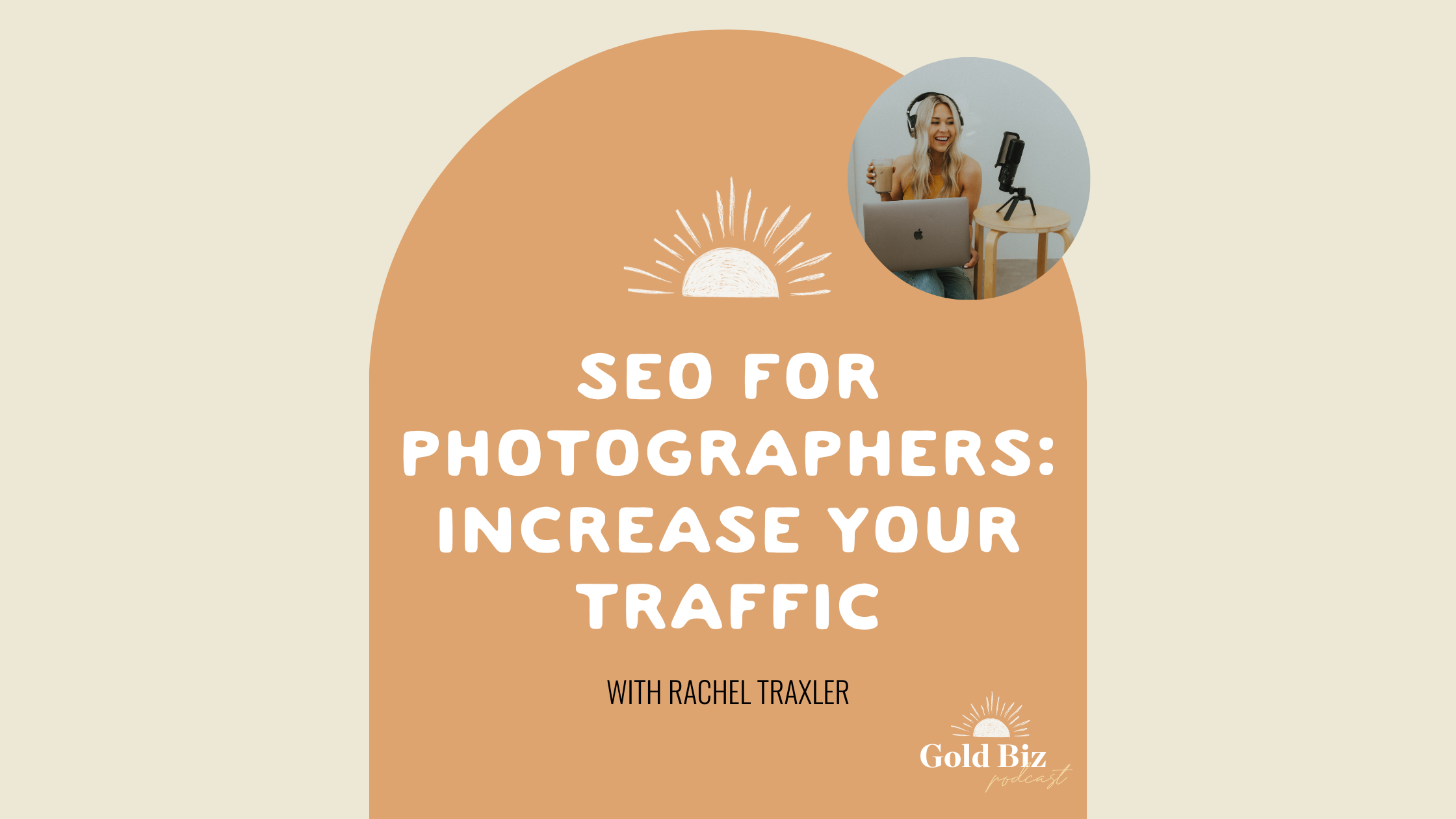Wondering how to improve your organic traffic and bring in more leads with less work? Here are some tips on SEO for photographers!
If you’ve ever wondered how to boost your SEO and create lead-generation strategies that don’t require constant attention, this post is for you. This post is with Lauren Taylar, an esteemed SEO expert specializing in the needs of photographers. We’ll cover the key elements of effective SEO for your website, with a particular focus on optimizing your blog posts. Lauren shares invaluable insights on attracting inquiries and generating leads through your blog.
SEO for Photographers: Steps to Boost SEO
One of the initial steps to improve SEO, especially for photographers, is resizing images before uploading them to their website galleries. This common mistake often leads to slow page load times, impacting the overall performance of the website. To optimize load times, it is crucial to resize images to a file size of under 500 kilobytes. Photographers often capture high-resolution photos that naturally have larger file sizes.
By reducing the image size, they can enhance website speed and user experience. This simple yet effective practice is highly recommended for all photographers and creatives looking to optimize their websites and improve SEO.
For optimizing SEO, one crucial step is image compression and optimization. It may seem like an extra task in your workflow, especially if you lack the necessary plugins. However, there are tools available to simplify this process. One highly recommended tool is JPEG mini, which efficiently reduces the file size of your images without compromising quality.
Another excellent option is tinyPNG.com or tinyJPEG.com, both offering similar functionality. These websites allow you to upload either file type and optimize up to 20 images for free. By manually resizing images with JPEG mini and then using tinyPNG.com or tinyJPEG.com, you can significantly minimize file size while preserving image quality.
Recommended SEO Tools
When it comes to SEO, one highly recommended tool for keyword research is UberSuggest. It allows you to identify the relevant words and phrases that should be incorporated into your website pages and individual blog posts. Having a blog is always recommended, and UberSuggest proves to be an affordable and effective SEO tool for small business owners.
It provides valuable insights, not only through comprehensive website audits but also by assisting in keyword research. Despite its affordability compared to other tools, UberSuggest offers a wealth of information to enhance your SEO strategy.
Where to leverage SEO to attract more inquiries
Lauren emphasizes the importance of blogging as a powerful tool to optimize SEO and reach the first page of Google search results. Having a well-defined strategy is crucial, focusing on creating content that aligns with what people are actively searching for. By strategically incorporating relevant keywords and phrases into blog posts, photographers can increase their website’s visibility and drive traffic from Google.
Additionally, Lauren highlights the significance of including a call to action at the end of each blog post. This ensures that your visitors are guided towards the next step, whether it’s through capturing leads with a freebie or encouraging them to explore the services page and ultimately reach out for further engagement.
Determining the keywords to improve ranking
In digital marketing, there are incredible tools that can assist in optimizing search engine visibility. One such tool is Uber Suggest and Lauren highly recommends it. It seamlessly integrates with web browsers like Google Chrome and Safari, and it can even work in conjunction with Answer the Public, a fantastic directory for researching popular search queries. Both Uber Suggest and Keywords Everywhere offer valuable insights.
They provide not only the search volume, revealing how many people search for a particular topic each month, but also the competition level. This metric indicates the difficulty of ranking for a specific keyword. These data points are extremely helpful.
Lauren advises using keywords with over a hundred monthly searches unless it’s a niche area like a specific town or city. As for competition, it’s best to aim for a score of 40 or lower on a scale of one to a hundred. Once you are armed with these two powerful tools, you can discover the precise words and phrases people are searching for and also identify which keyword you should be using.
Recommended types of specific and broad keywords
Lauren always noted that when searching for keywords, it’s common to come across broader terms. For instance, she mentioned the possibility of stumbling upon a lengthy keyword like “tips to finding the perfect photographer for your wedding.” Although it may seem lengthy, it could potentially be a valuable keyword with a search volume of around 3000.
She also states the importance of assessing the competition for such keywords. If the competition is high, do not target it immediately, it would be more prudent to wait until the blog is more established and capable of ranking for more competitive keywords. Nevertheless, Lauren still suggests that keywords with a search volume of around 3000 or less can be used. Taking note of the competition number is crucial, as it helps determine whether investing time and effort into ranking for a particular keyword in a blog post is worthwhile.
How to check rankings
Uber Suggest is immensely useful in checking rankings. Through this specific tool, one could visually track the increase in the number of keywords they were ranking for over time. The tool provides a clear representation of the keywords falling within different ranking positions, such as one to three and six to ten, all on the first page of Google. Also, it shows the rankings between pages two and three and beyond, providing valuable insights into the distribution of keywords across the first ten pages of search results.
This feature is particularly helpful for bloggers who are consistently publishing content for around four months. By entering their website into Uber Suggest, they can assess whether there was an upward trend in the number of keywords they were ranking for.
Another valuable resource is Google Search Console. Its accessibility as a free tool, makes it easy for anyone to set it up for their websites. This tool allows users to explore the specific words and phrases people are entering into Google’s search engine and determine which pages of their website are attracting clicks.
The ability to analyze click-through rates from Google search results offers valuable insights into the effectiveness of one’s SEO efforts. However, this process requires time and patience. While some progress can be seen within the first three to six months, significant results are not instantaneous. Also, Google Analytics will show an increase in traffic.
Keywords in social media content
Lauren doesn’t know much about social media and keywords but she knows that on Instagram, adding keywords like “photographer” and the city of work in the name or bio section makes profiles searchable. However, she has limited knowledge about Instagram’s enhanced search functionality.
When it comes to YouTube, she explains that optimizing videos differs from optimizing blog posts. Still, Lauren strongly encourages utilizing YouTube as it serves as a massive search engine that countless people rely upon.
Optimizing blog posts for SEO
To optimize a blog post for SEO, start by selecting a keyword related to the topic you want to write about. For example, if the topic is “tips for finding a photographer,” that becomes the keyword. Next, create a blog post title using that keyword. It is recommended to aim for at least a thousand words in the blog post. Google tends to favor longer-form content over shorter ones.
Within the blog post, naturally, incorporate the keyword three to four times. It is essential to avoid sounding spammy or robotic. The keyword mentions should flow naturally, preferably in the first sentence or paragraph, which is recommended for SEO purposes. Additionally, you can mention the keyword a couple of times throughout the post, including in the conclusion.
Breaking up the content with heading two tags is necessary. For instance, if the blog post is titled “Four Steps to Finding the Perfect Photographer,” each step should be a heading with two tags. This approach helps Google understand the hierarchy of the post and enables readers to scan and digest the content easily.
Paragraphs should be kept short, consisting of one to two lines, to enhance readability and engagement. Chunky paragraphs should be avoided as they may discourage readers from staying on the page for long. Furthermore, it is beneficial to include internal links to other relevant and valuable blog posts or external resources within the content.
In the introduction, engage the reader conversationally, addressing their excitement or needs. Rather than overthinking keyword placement, write the post first and then find opportunities to include keywords during the editing process. This approach takes the pressure off and allows for a more seamless optimization of your blog post.
Targeted landing pages to boost SEO
In website optimization, it’s important to assign a distinct keyword to each main page. This includes the homepage, about page, services page, investment page, and gallery. This enables the pages to target specific search terms apart from the blog content. Conducting thorough keyword research is important at this stage.
Do not use overlapping keywords among the pages, this will create competition between them. While it’s acceptable to mention related keywords organically across the site, it is essential to choose a primary keyword for each page.
For instance, if the About page focuses on “Miami wedding photographer,” it’s permissible to reference this term on the investment page. However, for optimal search engine optimization (SEO), incorporate the main keyword strategically in headings, image file names, and other relevant elements. Finally, optimize the main pages for SEO to enhance their potential for ranking on Google for their specific targeted keywords.
Final Advice
A frequent error observed on photographers’ websites is the excessive use of keywords, known as keyword stuffing. It is important to naturally incorporate relevant keywords into the website’s content. Mention them around two to three times depending on the length of the copy on each page. Because, repeatedly mentioning the same keyword, such as “Miami wedding photographer,” in various forms, like “I photograph weddings in Miami” or “as a Miami wedding photographer,” becomes tedious to read and hinders search engine optimization (SEO).
Furthermore, Lauren stresses that the focus should always be on the user, not solely on pleasing search engines like Google. When reading the website’s content aloud, if it sounds robotic or forced, it won’t provide an enjoyable experience for the user, who is ultimately the ideal client you aim to attract. Avoid the common mistake of keyword stuffing and avoid it at all costs.
Lauren can be found on Instagram @Lauren_Taylar and also at laurentaylar.com.


comment your thoughts below!